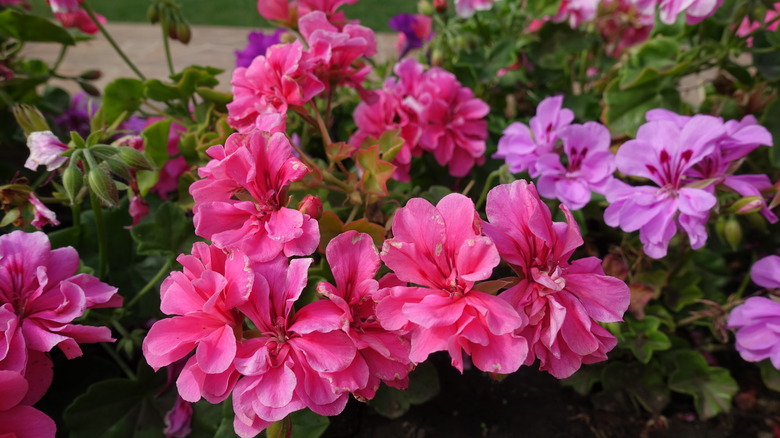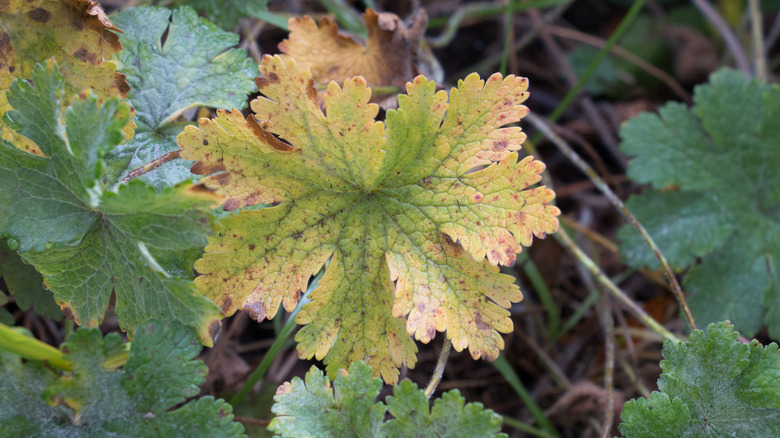Avoidable Mistakes That Are Killing Your Geraniums In The Garden
Geraniums are some of the most wholesome flowers you could ever have in your garden. Not only do they serve as major eye candy, but they also garnish dishes, and some species are known to repel yard pests like wasps and mosquitoes. There are over 400 species out there, and they are relatively easy to grow, which is why stumbling upon dead or dying geraniums in your garden is such a hard blow. There are several avoidable mistakes gardeners make while growing geraniums. If you don't learn to correct them, you're going to keep seeing your precious plants die. Water, sunlight, and good soil are three basic plant needs that, when done wrong, can spell the end of your geraniums.
Most plants don't just die overnight. If something is going wrong with your geraniums, you'll probably get a heads up as it's happening before the plant completely withers and kicks the bucket. It's important to pay attention to the signs and learn what your flowers are telling you. It's easy to slip up and do something that makes your geraniums unhappy. Common mistakes include inadequate light and overwatering. Keep a watchful eye on your plant's leaves for discoloration, the quality and quantity of the bloom during flowering season, and how wet or dry the soil is to know which mistakes you may be making.
Avoid full shade, water regularly, and prune your geraniums
Geraniums need to grow in full sunlight, and one of the mistakes you can make with them is forgetting this. Most of them don't cope well when planted in full shade. In constant full shade, garden geraniums won't bloom to their maximum capacity — a letdown for the season. Geraniums require about six hours of sun every day with some afternoon shade, so as a plant parent, you need to position them in the right spot for this.
Not planting your geraniums in well-draining soil is another critical mistake. Geraniums are drought-resistant and strongly dislike waterlogged soil. If you overwater your plant, it will have constantly drenched roots which will lead to root rot and eventual death. On the other hand, not watering enough is equally problematic. You should water your geraniums once or twice a week. During wintertime, this can be reduced. Also, avoid the mistake of watering the geraniums from overhead instead of targeting the soil directly, as this can lead to disease.
Not deadheading your geraniums enough is another mistake people make with them. You have to get rid of the old, browned leaves to make way for the new ones. Clip off woody stems and young ones to promote branching. Finally, avoid forgetting that geraniums have pests like aphids and whiteflies that seek to suck the life out of them. Inspect the undersides of the leaves regularly to make sure they're pest-free.
How to tell if these things are happening to your geraniums
Once you know what to avoid when growing geraniums, you should know what to look out for in case you're slacking on the job. When they aren't receiving enough sunlight, geranium leaves become discolored and turn yellow. It also gives a disappointing bloom. Although full sunlight is preferred, excess heat is discouraged because it can easily overwhelm the plants.
If your geranium is looking wilted, check the roots. Overwatering your plants can cause the roots to become waterlogged. If your roots are brown instead of white and healthy, then chances are they are waterlogged and damaged. Yellow leaves are also a sign of underwatered geraniums. Step up your watering game if you notice this symptom. If the soil around the plant is warm and dry a couple inches deep, water it deeply. If it's moist and cool, you're all good.
If you check your geranium's roots and they're nonexistent, that's a sign that you may have pests that ate them. Another sign of pests is shriveled-up, blackened leaves. This means you have aphids or whiteflies on the loose. As they feed on the leaf sap, they secrete sticky honeydew, which encourages black sooty mold. Get rid of the pests by blasting them off with cold water.


